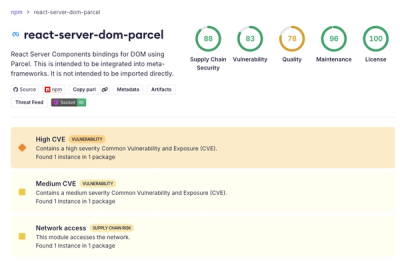
Security News
Deno 2.6 + Socket: Supply Chain Defense In Your CLI
Deno 2.6 introduces deno audit with a new --socket flag that plugs directly into Socket to bring supply chain security checks into the Deno CLI.
pywaterflood
Advanced tools
pywaterflood: Waterflood Connectivity Analysispywaterflood provides tools for capacitance resistance modeling, a
physics-inspired model for estimating well connectivity between injectors and
producers or producers and other producers. It is useful for analyzing and
optimizing waterfloods, CO2 floods, and geothermal projects.
A literature review has been written by Holanda, Gildin, Jensen, Lake and Kabir, entitled "A State-of-the-Art Literature Review on Capacitance Resistance Models for Reservoir Characterization and Performance Forecasting." They describe CRM as the following:
The Capacitance Resistance Model (CRM) is a fast way for modeling and simulating gas and waterflooding recovery processes, making it a useful tool for improving flood management in real-time. CRM is an input-output and material balance-based model, and requires only injection and production history, which are the most readily available data gathered throughout the production life of a reservoir.
There are several CRM versions (see Holanda et al., 2018). Through passing different parameters when creating the CRM instance, you can choose between CRMIP, where a unique time constant is used for each injector-producer pair, and CRMP, where a unique time constant is used for each producer. CRMIP is more reliable given sufficient data. With CRMP, you can reduce the number of unknowns, which is useful if available production data is limited.
You can install this package from PyPI with the line
pip install pywaterflood
Or from conda/mamba with
conda install -c conda-forge pywaterflood
Then, read the docs to learn more. If you want to try it out online before installing it on your computer, you can run this google colab notebook.
import numpy as np
import pandas as pd
from pywaterflood import CRM
gh_url = "https://raw.githubusercontent.com/frank1010111/pywaterflood/master/testing/data/"
prod = pd.read_csv(gh_url + 'production.csv', header=None).values
inj = pd.read_csv(gh_url + "injection.csv", header=None).values
time = pd.read_csv(gh_url + "time.csv", header=None).values[:,0]
crm = CRM(tau_selection='per-pair', constraints='up-to one')
crm.fit(prod, inj, time)
q_hat = crm.predict()
residuals = crm.residual()
print("MAE by well:", np.round(np.abs(residuals).mean(axis=0), 2), "barrels")
print("MAPE by well:", np.round(np.mean(np.abs(residuals) / prod * 100, axis=0), 2), "percent")
print("RMSE by well:", np.round(np.sqrt(np.sum(residuals**2, axis=0)), 2))
Contributions are extremely welcome! Have an issue to report? Want to offer new features or documentation? Check out the contribution guide to help you set up. Discussions could start anytime at the discussions section.
pywaterflood uses Rust for computation and python as the high level interface.
Luckily, maturin is a very convenient tool for working
with mixed Python-Rust projects.
Running tests, building the package, linting to conform to code standards, and building the documentation are all handled by nox.
The guide for getting started, has instructions for installing rust, python, and nox. At that point, both the lint and unit test sessions are run with the command
nox
This software library is released under a BSD 2-Clause License.
Capacitance resistance modeling would not have caught on without the persistence of two professors: Larry Lake and Jerry Jensen. Both of these gentlemen generously helped answer questions in the development of this library. Research funding for this project came from the Department of Energy grant "Optimizing Sweep based on Geochemical and Reservoir Characterization of the Residual Oil Zone of Hess Seminole Unit" (PI: Ian Duncan) and the State of Texas Advanced Resource Recovery program (PI: William Ambrose). Further development is supported by Penn State faculty promotion funds and volunteer time.
FAQs
Physics-inspired waterflood performance modeling
We found that pywaterflood demonstrated a healthy version release cadence and project activity because the last version was released less than a year ago. It has 1 open source maintainer collaborating on the project.
Did you know?

Socket for GitHub automatically highlights issues in each pull request and monitors the health of all your open source dependencies. Discover the contents of your packages and block harmful activity before you install or update your dependencies.

Security News
Deno 2.6 introduces deno audit with a new --socket flag that plugs directly into Socket to bring supply chain security checks into the Deno CLI.

Security News
New DoS and source code exposure bugs in React Server Components and Next.js: what’s affected and how to update safely.

Security News
Socket CEO Feross Aboukhadijeh joins Software Engineering Daily to discuss modern software supply chain attacks and rising AI-driven security risks.